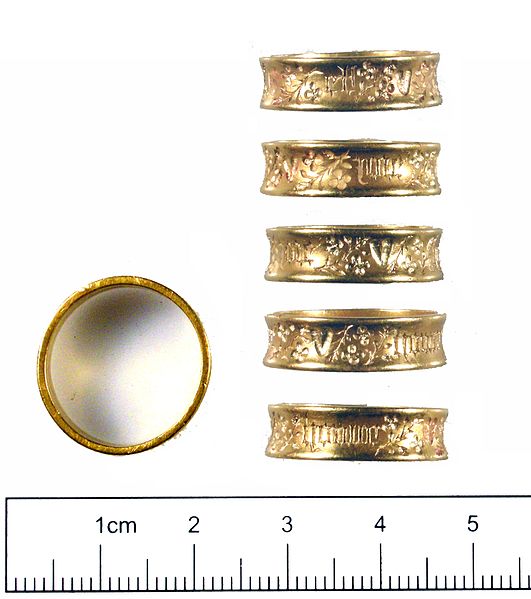May 2017 proved a good month for news of rediscovered
fifteenth-century treasures. Shortly after the emergence of the Caxton leaf,
reports appeared about a treasure from Kirby Muxloe Castle that is due to be auctioned
this August. It’s a gold, heart-shaped brooch that was discovered by a metal
detectorist near the castle moat last year. It is inlaid with white enamel but
what has caught the attention of reporters is the engraving inside of tiny
flowers and the words ‘honor et joie’. It is being presented as a romantic gift
from the castle’s most famous inhabitant, William Lord Hastings, to his wife
Katherine Neville, who was one of Warwick the Kingmaker’s sisters.
Of course, determining the context of a piece of jewellery
is no easy task. In 1866, as a railway was being cut through the outskirts of
Clare Castle in Suffolk, an exquisite gold reliquary crucifix, set with pearls,
was discovered. At first it was believed to be of fourteenth-century origin and
attempts were made to identify it with members of Edward III’s family. Only
later did experts decide it was really an early fifteenth century treasure.
Similarly, the more famous Middleham Jewel, discovered in 1985, has been
associated with various dates from 1425 to 1499.
It is even more difficult to suggest who might really have
owned such treasures. The Clare Reliquary is widely associated with Richard III’s
mother, Cecily duchess of York, who was the lady of Clare Castle for most of
the fifteenth century. Yet her sister-in-law, Isabel Bourchier, famously held a
Twelfth Night party at the castle in 1445 and any number of wealthy noblewomen
must have walked through the castle’s tranquil riverside grounds during the
fifteenth century. The Middleham Jewel is also often associated with Cecily
(despite her minimal connections with Middleham) or, more plausibly, with
Richard III’s wife, Anne Neville. Yet it is large enough to have belonged to a
man and might just as easily have belonged to Anne’s mother or grandmother. Indeed,
a case could be made that its first owner was Anne’s great grandmother
(Cecily’s mother), Joan Beaufort, countess of Westmorland who bequeathed a
great jewel called ‘the Trinity’ to Richard, earl of Salisbury (and lord of
Middleham).[1]
So what of the owner of the Kirby Muxloe Brooch? The press
releases offer it as a romantic ‘sweetheart brooch’ from Lord Hastings to his
wife. Yet few men in the fifteenth-century have such a licentious reputation as
Hastings: Mancini recorded that he was ‘an accomplice and a partner’ in Edward
IV’s ‘privy pleasures’, and he located the origin of Hastings’s feud with the
marquis of Dorset in squabbles over their shared mistresses. The Great
Chronicle of London numbers Elizabeth (Jane) Shore among his lovers. If the
brooch really was a gift from Hastings to Katherine it is hard to imagine it as
the product of a charming love story in turbulent times. Hastings had surely
chosen his bride for her political connections rather than for love and David
Baldwin referred to her as a ‘reward’ from Edward IV for Hastings’s loyalty in
1461.[2]
Could the brooch have been for a mistress? The secret motto
seems rather inappropriate for that, although Hastings’s confidence in his own
position might just have led him to imagine a mistress felt honoured by his
attentions. There must of course have been many other ladies who visited the
castle, or the previous manor house on the same site. Nonetheless, the very
short history of the castle as a residence does mean that Katherine Neville
remains the brooch's most likely owner.
Neither the design nor the motto on the brooch are any guide to help with identification since the same motto appears on a number of late medieval rings that have been found across the country over the years. Interestingly several of these seem to have been religious rather than secular tokens: one of them was found in in the tomb of Archbishop Bowet of York (d 1423) and two have engravings of saints including the Virgin Mary on their bezels.[3] Brooches engraved with or shaped as hearts look to have been very common in the later middle ages. Perhaps the most famous is the blue and gold enamelled heart from the Fishpool Hoard (probably buried 1463-4) but around 50 have apparently been found along the Thames foreshore alone.[4]
Neither the design nor the motto on the brooch are any guide to help with identification since the same motto appears on a number of late medieval rings that have been found across the country over the years. Interestingly several of these seem to have been religious rather than secular tokens: one of them was found in in the tomb of Archbishop Bowet of York (d 1423) and two have engravings of saints including the Virgin Mary on their bezels.[3] Brooches engraved with or shaped as hearts look to have been very common in the later middle ages. Perhaps the most famous is the blue and gold enamelled heart from the Fishpool Hoard (probably buried 1463-4) but around 50 have apparently been found along the Thames foreshore alone.[4]


Fifteenth century gold ring engraved with the words 'honur et joie' (more details here)
It
is striking that the auctioneers have set the guide price for the Kirby Muxloe
brooch at just £6,000-£8,000. That is a tiny fraction of the value of that one
leaf of paper from the book that Caxton had sold ‘good chepe’ at about the same
time that the brooch must have adorned a noblewoman’s gown.
J L Laynesmith
[1]
For more on the Clare Reliquary Cross and Joan Beaufort’s jewellery, see J L
Laynesmith, Cecily duchess of York (2017), 141-2.
[2] For more on Katherine Neville see David Baldwin, The Kingmaker’s Sisters (2009)
[3]
Lincolnshire History and Archaeology 16 (1981), 83
[4] Roberta Gilchrist, Medieval Life: Archaeology and the Life Course (2013), 110
